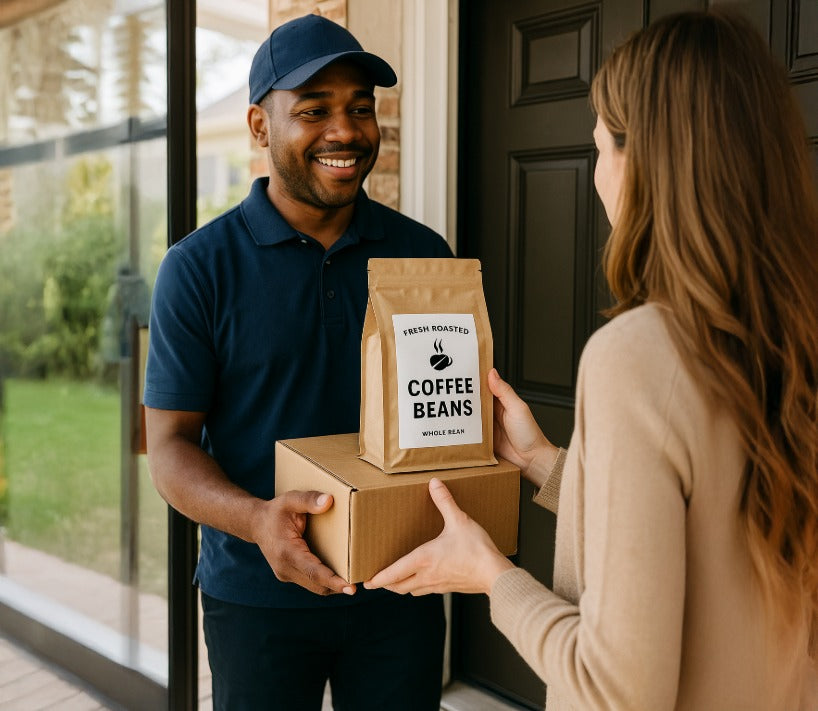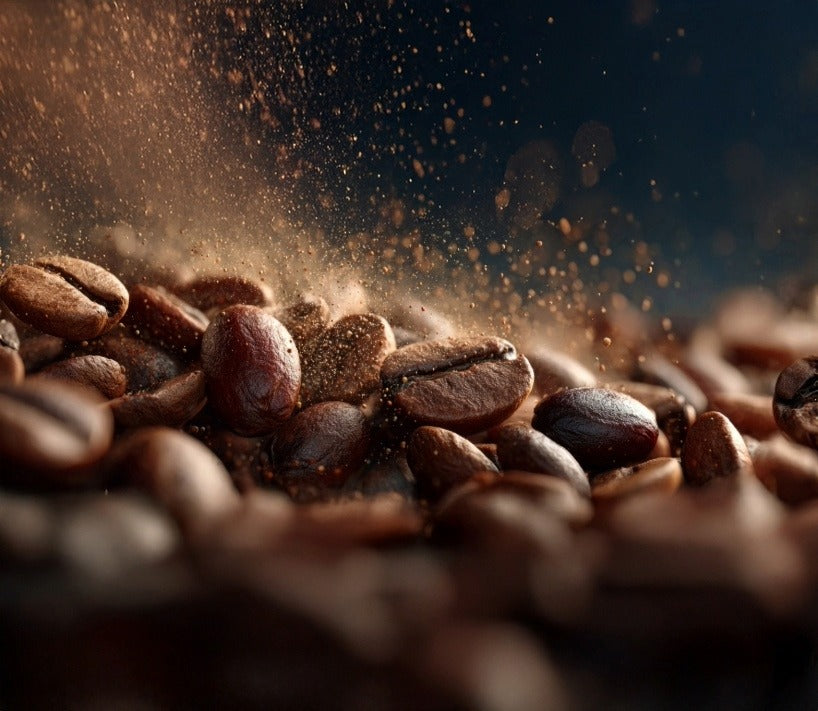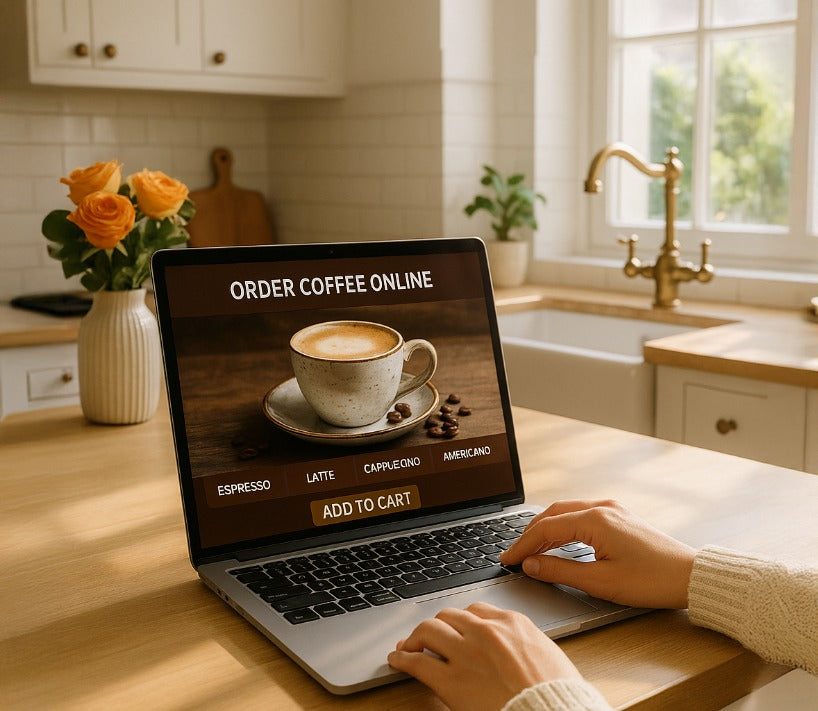Best Coffee To Buy at Home: How Elisa Dumped Energy Drinks and Found “Morning Magic”
August 08, 2025 6 min read
Best Coffee To Buy at Home: How Elisa Dumped Energy Drinks and Found “Morning Magic”
If you’ve ever wondered what the best coffee to buy at home is (and why it tastes a million times better than “whatever’s in the office kitchen”), here’s a cheerful, 3rd-grade-level story with big-kid facts. My friend Elisa used to chug energy drinks like a tiny rocket ship. Then she graduated to caffeine pills—yikes, science class in a tablet. She thought all coffee tasted the same: GROSS. One cup of fresh, high-scoring, air-roasted specialty coffee later and—boom—mind blown. No more cans. No more pills. Just a warm mug of “morning magic” that actually tastes like… happiness that can read.
Best coffee to buy at home: Elisa’s tiny adventure with huge flavor
Picture it: Monday morning, fluffy slippers, a cat judging you. Elisa reaches for her usual neon energy drink. I say, “Hold up. Let’s play a new game called Sip the Magic Bean.” We grind fresh beans (they smell like chocolate and sunshine had a baby), use hot water that’s not boiling (195–205°F, because we’re fancy), and make a simple pour-over.
Elisa takes one sip and makes the face you make when you find $20 in your winter coat. “Wait. Coffee can taste like this?” Yes, friend. Yes it can. And yes, it still has the pep—but without the super-sweet syrup or mystery-pill vibe.
Here’s why fresh, high-scoring, air-roasted specialty coffee changed everything for Elisa—and why it might be your new superhero too.
What “high-scoring specialty coffee” actually means (no secret handshake required)
In the coffee world, beans are graded on a 100-point scale by trained tasters. Specialty coffee means the beans score 80+ points on that scale. When folks say “high-scoring,” think mid-80s and above—beans with cleaner flavors, fewer defects, and tasting notes that sound like a dessert menu (berries, caramel, cocoa, florals). That’s what you want if you’re hunting for the best coffee to buy at home or the best coffee to buy online without needing a PhD in beanology.
Why “air-roasted” can taste extra clean
Most coffee is roasted in a drum; air-roasting (a “fluid-bed” roaster) uses hot air to lift and tumble beans evenly. This helps shed papery chaff quickly and can reduce smoky, bitter notes. The result? A bright, clean cup that lets the bean’s true flavors shout “HELLO!” instead of whispering behind a campfire.
Caffeine, sugar, and antioxidants—the kid-simple science
-
Caffeine: A normal 8-oz cup of brewed coffee has about 80–120 mg. Energy drinks vary a lot (roughly 80–160 mg per can, size-dependent). Caffeine pills are often 100–200 mg in one gulp.
-
Sugar: Plain coffee has 0 g sugar (unless you sweeten it). Many energy drinks have a lot of added sugar.
-
Antioxidants: Coffee naturally packs polyphenols (like chlorogenic acids). Fancy word, simple idea: these compounds have antioxidant activity. No need for capes.
Elisa realized coffee could deliver a steady, friendly lift, taste amazing, and skip the sugar rush. So, goodbye cans and pills; hello Best craft coffee at home mornings.
Quick comparison: What should you actually sip?
Here’s a simple table to compare common “wake-up” choices. (Approximate ranges—labels and brew strength vary.)
| Option | Typical Caffeine per Serving | Typical Sugar | Antioxidants | Flavor Experience | Pros | Cons |
|---|---|---|---|---|---|---|
| Energy drink (8–16 oz) | ~80–160 mg | Often 0–40 g | Low | Candy-soda vibes | Convenient | Sugar or artificial sweeteners; can be fizzy-harsh |
| Caffeine pill (1 tab) | ~100–200 mg | 0 g | None | …like swallowing homework | Precise dose | No flavor, no sipping joy |
| Grocery “generic” coffee | ~80–120 mg (8 oz) | 0 g | Medium | Bitter/burnt common | Cheap, familiar | Stale beans = flat flavors |
| Air-roasted specialty coffee | ~80–120 mg (8 oz) | 0 g | Medium–High | Clean, sweet, nuanced | Fresh taste; tons of origin variety | Needs grinder + simple brew method |
If you enjoy learning and flavor (and we’re here reading a coffee blog, so… yes), air-roasted specialty wins for everyday sipping.
How Elisa went from “ew” to “ooh!” in three cups
-
Cup 1: Light-medium roast, fruity
“It tastes like berries? In coffee?” Yep. Because beans are fruit seeds. Mind. Bonk. -
Cup 2: Medium roast, chocolatey-nutty
Comfort vibes. Elisa said, “I could drink this every day.” -
Cup 3: Washed vs. natural process taste-off
Washed = cleaner, sparkling clarity. Natural = fruitier, jammy. Elisa learned her taste in one mini science fair.
Suddenly, she’s planning her week around her brew, not her next can. That’s a victory dance with a mug.
The tiny toolkit for big flavor at home
You don’t need barista tattoos. Just a grinder, good water, and a simple brewer.
-
Grind fresh. Burr grinder > blade chopper. Freshly ground = fuller aroma and taste.
-
Water temp: 195–205°F (about 30 seconds off boil).
-
Recipe: Start near 1:16 coffee:water (e.g., 25 g coffee to 400 g water). Adjust taste: too sour → grind finer; too bitter → grind coarser.
-
Store beans smart. Whole beans in a sealed, opaque container; cool, dry place; use within ~2–4 weeks of roast for peak flavor.
If you order coffee online, look for roast dates, not just “best by.” Freshness shows.
Choosing the best coffee to buy at home (the super-simple checklist)
When you’re browsing top specialty coffee online (or walking into a local roaster), use this:
-
Look for roast date. Fresher = brighter, livelier flavors.
-
Check the score or tasting notes. “Specialty,” “85+ points,” or clear flavor notes like “cocoa, cherry, almond.”
-
Match the roast to your brew style.
-
Pour-over/AeroPress: light to medium for clarity.
-
Drip machine: light-medium to medium for balance.
-
Espresso: medium to medium-dark for body and sweetness.
-
-
Pick the origin vibe you like.
-
Africa (often Ethiopia/Kenya): floral/berry.
-
Latin America (often Colombia/Guatemala/Costa Rica): chocolate, caramel, citrus.
-
Asia (often Sumatra/Papua New Guinea): earthy, spice, cocoa.
-
-
Prefer air-roasted if you like “clean.” It often pops with sweet clarity.
-
Grind at home. Whole beans beat pre-ground every time for aroma and sweetness.
Many roasters also offer best coffee online free shipping thresholds or subscription perks—handy if you’re exploring consistently (and want the freshest craft coffee online without extra fees).
Decoding labels (Elisa-style)
-
“Natural” process = fruitier, jammier.
-
“Washed” = sparkling, tea-like clarity.
-
“Honey” = balanced sweetness, medium body.
-
“Single origin” = beans from one place—clear, distinct taste.
-
“Blend” = mixed origins—balanced and versatile.
-
“Tasting notes” = flavors you might notice, not syrups added. It’s like the bean’s personality.
Why delivery doesn’t have to mean “stale”
For the best coffee bean delivery, timing is everything. Look for roasters who:
-
Roast to order (ship within 24–72 hours of roast).
-
Share the roast date on the bag.
-
Seal bags with one-way valves so CO₂ can escape but oxygen stays out.
That way, when you order coffee online, your bag arrives ready for its close-up (and your cup).
Your 7-day “Morning Magic” challenge
Elisa swears by this tiny plan. No salesy stuff—just steps:
Day 1–2: Pick one specialty bag (light-medium roast). Brew it at 1:16. Write down three words you taste.
Day 3–4: Adjust grind to tune sweetness. Too sharp? A bit finer. Too bitter? A bit coarser.
Day 5: Try a different water: filtered vs. tap. (Yes, water changes everything.)
Day 6: Brew back-to-back cups: washed vs. natural (or two different origins).
Day 7: Decide your favorite flavor lane. Now you know how to find the best coffee to buy at home for you—consistently.
When you feel ready for level-up mode, explore two origins side-by-side. That’s how you discover your personal Best craft coffee at home lineup and choose the best coffee to buy online with confidence.
Fast FAQ (for brains that like easy buttons)
Q: Is specialty coffee really healthier than energy drinks?
A: “Healthier” depends on your whole diet, but plain coffee has zero sugar by default and naturally contains antioxidant compounds. Many energy drinks are sugary or rely on additives. Always check labels and your own needs.
Q: Does air-roasted coffee have less bitterness?
A: It can taste cleaner because hot air promotes even roasting and chaff removal, which may reduce smoky or harsh flavors. Bitterness also comes from over-extraction, stale beans, or too-fine grind—so your brewing technique matters, too.
Q: How do I store beans for max freshness?
A: Keep whole beans in an airtight, opaque container at room temp—cool, dry, no sunlight. Avoid the fridge/freezer once the bag is open (moisture is the enemy).
Q: What grind size should I use?
A: Start medium for drip/pour-over, finer for espresso, coarser for French press. Adjust to taste.
Q: Can I get great results with a drip machine?
A: Absolutely. Use fresh, high-scoring beans, the right grind, a clean machine, and a good ratio. Paper filters can make the cup extra clean.
Q: Where do I find the freshest craft coffee online?
A: Look for roasters who publish roast dates, roast-to-order, and ship quickly. Many offer best coffee online free shipping thresholds, too.
Tiny takeaway
Elisa didn’t need a lab coat, a sugar crash, or a mystery tablet. She needed beans with flavor, a basic grinder, and water that wasn’t boiling. That’s it. If you’re hunting the best coffee to buy at home, chase freshness, high scores, and (if you love bright clarity) air-roasted magic. Then sip like a champion who also remembers to tie their shoes.
Now go forth and brew. If Elisa can trade neon fizz for a mug of magic, your Monday can glow too.
Also in Best Coffee To Buy Online Education

Best Fresh Roasted Coffee Delivery Online
November 28, 2025 4 min read
I roast the best tasting coffee at home for you! I use 100% electric equipment, so no hydrocarbons here. Best fresh roasted coffee delivery starts with high-scoring specialty coffee online.

Which Roaster Makes Better Coffee: Gas or Electric?
November 27, 2025 4 min read
Why electric drum roasters produce cleaner, sweeter, more consistent coffee—especially the kind you want when buying fresh roasted coffee beans online or trying to make the best tasting craft coffee at home.

Biggest Coffee Buying Mistake at Home
November 26, 2025 4 min read
Learn why the roast date matters and how to buy fresh, high-quality specialty coffee online. No guesswork when you order coffee online with me. I only stock, roast, and process the best tasting craft coffee at home. I am YOUR personal roaster.
